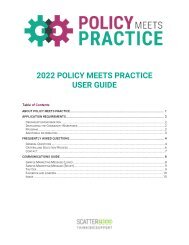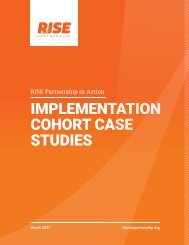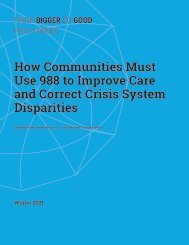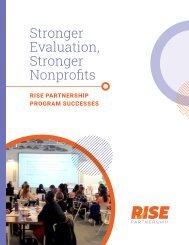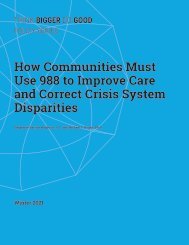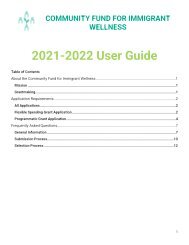Alternative Payment Models
You also want an ePaper? Increase the reach of your titles
YUMPU automatically turns print PDFs into web optimized ePapers that Google loves.
Telehealth<br />
As technology for telehealth has become increasingly<br />
available and easy to use, it has progressively been cited<br />
as a potential solution for treatment disparities and longrecognized<br />
obstacles to care in the United States. At present,<br />
at least 20% of Americans live in areas where shortages of<br />
physicians and healthcare specialists exist, and many others<br />
experience structural barriers to initiating or continuing<br />
care. 43, 44 Telehealth services offer a potential solution to<br />
improving access to care, especially in rural and otherwise<br />
underserved areas (including urban settings). Given the<br />
shortage of specialty behavioral clinicians both in rural and<br />
urban areas, tele-mental health—if expanded to all geographic<br />
areas—can significantly improve access to mental healthcare.<br />
The Veterans Health Administration (VHA) has been a<br />
national leader in this area for years. This is partly due to<br />
the multiple unique characteristics that make the VHA a<br />
well-suited organization for tele-healthcare: a uniform<br />
electronic medical record, a lack of state-specific provider<br />
licensure regulation, and a relatively tech-savvy patient<br />
subpopulation (from recent experience serving in the<br />
military). 45 This APM facilitates the expansion of telehealth<br />
services by incentivizing the use of existing payment codes.<br />
(Example provided by the AIMS Center.)<br />
Transitional Care<br />
Bundled <strong>Payment</strong>s<br />
Reimbursing healthcare services via a bundled payment is<br />
intended to reduce unnecessary spending, incentivize valuebased<br />
care, and encourage care coordination. The application<br />
of bundled reimbursement models has lagged in mental health<br />
compared with other specialties, although some notable<br />
46, 47, 48, 49, 50<br />
examples and theories have been described.<br />
Bundled payments could compel systems and payers to<br />
focus on well-described critical time windows for behavioral<br />
health patients, such as transition of care from inpatient to<br />
outpatient settings or vice versa. 51, 52 Overdoses and suicides<br />
disproportionately present in the emergency department,<br />
demonstrating the necessity of care transitions to adequate<br />
and proactive follow-up. One potential setting for a pilot<br />
bundled payment could be in the emergency department; for<br />
the first time, the 2017 HEDIS measures included “Follow-Up<br />
After Emergency Department Visit for Mental Illness” and<br />
“Follow-Up After Emergency Department Visit for Alcohol and<br />
Other Drug Dependence.” 53 The 2018 HEDIS document has<br />
expanded and clarified these measures. 54 Given the welldescribed<br />
hospital practice changes surrounding transition<br />
of care in response to bundled payments for other diagnoses,<br />
an initiative in behavioral health could conceivably move<br />
the needle toward reducing the large number of preventable<br />
hospital readmissions. (Example provided by the AIMS Center.)<br />
<strong>Payment</strong> Reform and Opportunities for Behavioral Health: <strong>Alternative</strong> <strong>Payment</strong> Model Examples 15





